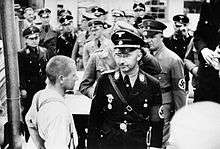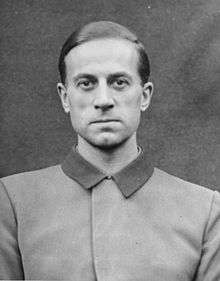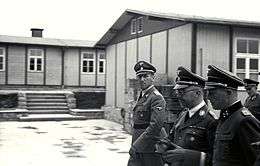Sonderbehandlung

Sonderbehandlung (abbr. S.B.) is a German noun meaning special treatment in English, also existing as a verb: sonderbehandeln (to treat specially). While it can refer to any sort of preferential treatment, it is known primarily as a euphemism used by Nazi functionaries and the SS for mass murder. It first came to prominence during Action T4, where SS doctors killed mentally ill and disabled patients between 1939 and 1941, and was one of a number of nonspecific words the Nazis used to document mass murder and genocide. Another notable example was Sonderbehandlung 14f13.
This term was also used to imprecisely refer to the equipment used to perpetrate their crimes, such as gas chambers and Zyklon B. The true meaning of Sonderbehandlung was widely known in the SS, and in April 1943, Reichsführer-SS Heinrich Himmler was so concerned about the security of it that he had it redacted in a secret report.
Berel Lang states that disguised language was used "...not only in communications issued to the Jewish public when the intention of those issuing the communications was to deceive the Jews in order to minimize the likelihood of resistance, but also in addresses to the outside world and, perhaps more significantly, in internal communications as well, among officials who unquestionably knew (who were themselves sometimes responsible for) the linguistic substitutions stipulated by the language rules."[1]
Background

By the summer of 1941, Action T4 became widespread public knowledge in Germany (and also in neutral countries and to Germany's enemies), and on August 24, 1941, Hitler ordered the joint chief of the operation Dr. Karl Brandt to halt it due to public protest (however it still continued, not only out of the public eye but in greater intensity).[2] Hitler did not want to run the risk of an order publicly embarrassing him again and, as a result, the explicit order to carry out the Holocaust was given by him orally. Even if there had been any written instances of this order, they would have almost certainly been destroyed by the Nazis when they realised their defeat was inevitable.[3]
Where the Nazis had to document murder, Sonderbehandlung was one of a number of euphemisms used. The Action T4 doctors used "desinfiziert" (decontaminated) to document the gassing of mentally ill and handicapped individuals.[4] The actual plan to exterminate the Jews of Europe was called "Die Endlösung der Judenfrage" (Final Solution to the Jewish Question). Other words to describe extermination operations included:
- "Evakuierung" (evacuation)
- "Aussiedlung" (expulsion)
- "Umsiedlung" (resettlement)
- "Auflockerung" (thinning out – as in the removal of inhabitants from a ghetto)[5]
- "Befriedungsaktion" (pacification)[5]
- "Ausserordentliche Befriedungsaktion" or "A.B. Aktion" (special pacification)[5]
- "Abwanderung" (having-been-migrated)[5]
- "Säuberung" (cleansing)[5]
- "Sicherheitspolizeilich durchgearbeitet" (directed or worked through in a manner in accordance with the Sicherheitsdienst)[5]
The Posen speeches made by Heinrich Himmler in October 1943 are the first known documents in which a high-ranking member of the Nazi government spoke explicitly about the perpetration of the Holocaust during the war. Himmler mentions the "Judenevakuierung" or "evacuation of the Jews", which he uses synonymously with their extermination.[6] At one point in the speech, Himmler says: "elimination of the Jews, extermination, we're doing it", briefly pausing in the middle of "elimination" (Ausschaltung) before going on to say "extermination" (Ausrottung).[6] His hesitation in the middle of saying "elimination" can be considered as a quick mental check to see whether or not it is acceptable to use such words in front of his given audience.[6] The answer is yes: it is the seniority of the SS in private. This has been compared to another incident of self-verification in the opposite way, where Josef Goebbels, in his Total War speech on February 18, 1943, begins to say "Ausrottung des Judentums" ("extermination of Jewry") but switches to saying "Ausschaltung", bearing in mind that he is speaking very publicly.[6] His resulting phrasing is "Ausrott...schaltung des Judentums", which can be likened to "exterm...elimination" in English.[6]
Usage

The term first appeared on September 20, 1939 in a decree by the Gestapo and Sicherheitsdienst chief SS-Obergruppenführer Reinhard Heydrich to all state police departments:
- "To avoid any misunderstandings, please take note of the following: ...a distinction must be made between those who may be dealt with in the usual way and those who must be given special treatment. The latter case covers subjects who, due to their most objectionable nature, their dangerousness, or their ability to serve as tools of propaganda for the enemy, are suitable for elimination, without respect for persons, by merciless treatment (namely, by execution).[7]
However, the usage is directed against Germans rather than Jews (it relates to "the principles of internal state security in the war"). Nevertheless, the law allowed for the killing of any person the regime wished. A memo dated six days later from a meeting at the SS-Reichssicherheitshauptamt defines Sonderbehandlung with "execution" following it in brackets.[7]
A report from the Eastern Front dated October 25, 1941, reads that "due to the grave danger of epidemic, the complete liquidation of Jews from the ghetto in Vitebsk was begun on October 8, 1941. The number of Jews to whom special treatment is to be applied is around 3,000."[7] An excerpt of a decree dated February 20, 1942, from the RSHA and written by Himmler regarding the treatment of "foreign civilian workers" advises that in particularly difficult cases, application should be made to the RSHA for special treatment, adding that "special treatment takes place by hanging."[8] In a letter to the RSHA, SS-Hauptsturmführer Heinz Trühe requests additional gas vans for "...a transport of Jews, which has to be treated in a special way..."[9] The gas vans were vehicles containing an airtight compartment in which the victims were locked and the exhaust gas was pumped into, killing the victims with the combined effects of carbon monoxide poisoning and suffocation.
Equipment

In German, "Sonder-", meaning "special", can be used to form compound nouns. As well as in reference to actions, the Nazis used euphemisms to refer to the actual equipment used to carry out killing. In his letter, Trühe refers to the vans as "S-wagen" (S-vans); "Sonderwagen" (special vans) in full. Other documented references include "Sonderfahrzeug" (special vehicle), "Spezialwagen" (special van), and "Hilfsmittel" (auxiliary equipment).[10]
Several instances of this unspecific language in reference to equipment can be found in documents concerning Auschwitz concentration camp. A letter dated August 21, 1942 referred to Bunker 1 and Bunker 2 (farmhouses west of Birkenau converted into gas chambers) as "Badeanstalten für Sonderaktionen" (bathing installations for special actions).[11] In the letter, this is given in quotes, further suggesting the euphemistic nature of what is meant. On blueprints, the basement gas chambers of Crematoria II and III were simply marked as "Leichenkeller 1" (basement morgue 1), and the basement undressing rooms were marked as "Leichenkeller 2". However, a letter dated November 27, 1942 to chief Auschwitz architect SS-Sturmbannführer Karl Bischoff referred to morgue 1 of Crematorium II as the "Sonderkeller" (special cellar).[12] A letter from SS-Sturmbannführer Rudolf Jährling concerning Crematoria II and III to oven builders J.A. Topf and Sons dated March 6, 1943, refers to morgue 2 as an "Auskleideraum" (undressing room).[13] The units of prisoners forced to empty gas chambers and load bodies into ovens were known as the Sonderkommando (special squads). A document dated August 26, 1942 granted the camp authorities to send a truck "...to Dessau to pick up material for special treatment..." - Dessau was one of two places where Zyklon B was manufactured.[14] Standard usage of the term for killing at Auschwitz applied. A letter dated October 13, 1942, signed by Bischoff, states that construction of new crematoria facilities "...was necessary to start immediately in July 1942 because of the situation caused by the special actions."[15] On September 8, 1943, 5,006 Jews were transferred from Theresienstadt to Auschwitz under the designation "SB six months."[16] Six months later on March 9, 1944, those still alive were gassed.[16] In his diary, SS-Obersturmführer and doctor Johann Kremer describes seeing a mass gassing for the first time:
- September 2, 1942: For the first time, at 3:00 A.M. outside, attended a special action. Dante's Inferno seems to me almost a comedy compared to this. They don't call Auschwitz the camp of annihilation for nothing![17]
Three days later, Kremer described the mass gassing of emaciated prisoners, nicknamed Muslims:
- September 5, 1942: In the morning attended a special action from the women's concentration camp (Muslims); the most dreadful of horrors. Master-Sergeant Thilo (troop doctor) was right when he said to me that this is the anus mundi. In the evening towards 8:00 attended another special action from Holland [sic]. Because of the special rations they get a fifth of a liter of schnapps, 5 cigarettes, 100 g salami and bread, the men all clamor to take part in such actions. Today and tomorrow (Sunday) work.[17]
In a letter dated January 29, 1943 by SS-Sturmbannführer Bischoff to SS-Oberführer Hans Kammler, Bischoff refers to basement morgue 1 of Crematorium II at Auschwitz as a "Vergasungskeller", literally "gassing cellar".[18] In the letter, the word is underlined, and at the top of the document is written: "SS-Untersturmführer Kirschnek!"[19] There was a very clear policy in the architecture office that words such as "gas chamber" should not be used; Second Lieutenant Kirschnek should be informed of this slip.[19] Citing this unique letter, Robert Jan van Pelt states that in using "special action" or "special treatment" in place of extermination and killing, the first Holocaust deniers were the Nazis themselves, in that they attempted to deny to themselves what they were doing.[19]
Sensitivity
Heinrich Himmler became increasingly concerned about the security of documenting the destruction of the Jews.[20] On April 9, 1943, he wrote a secret letter to Heydrich's successor as chief of the Gestapo and SD, SS-Obergruppenführer Ernst Kaltenbrunner, concerning the Korherr Report.[20] Himmler considered the report "well executed for purposes of camouflage and potentially useful for later times."[20] The next day, SS-Obersturmbannführer Rudolf Brandt passed a message to the author of the report, Richard Korherr, stating:

The Reichsführer-SS has received your report on "The Final Solution of the European Jewish Question". He wishes that "special treatment of the Jews" not be mentioned anywhere. On page 9, it must be formulated as follows:
- "They were guided:
- through the camps in the General Government
- through the camps in the Warthegau"
- No other formulation is to be employed.[8]
Himmler was so sure that almost everyone knew what "special treatment" meant, and ordered for it to be replaced with the even more vague "durchgeschleust" (guided through), even though the document in question was top secret.[8] The camps in question in the General Government were Treblinka, Sobibor and Belzec extermination camps, and Majdanek concentration camp. The only camp in the Warthegau was Chełmno extermination camp.

Nazi perspectives
In the course of investigations and criminal proceedings for Nazi war crimes, it was shown that among those involved, there was no doubt what was meant by this term. At his trial, SS-Obersturmbannführer Adolf Eichmann stated that "everybody knew" special treatment meant killing.[21]
According to SS-Gruppenführer and senior SS and Polizeiführer Emil Mazuw:
- "During the war, the SS gave no meaning to Sonderbehandlung other than killing. I am certain that high-ranking officers knew it. I don't know whether the ordinary SS man did or not. According to the terminology used at the time, I understand 'special treatment' to mean only killing and nothing else."[7]
See also
References
- ↑ Lang (2003), p. 93
- ↑ Friedlander (1997), p. 111
- ↑ "Myth/Fact Sheet: Hitler never ordered the Holocaust". Emory University. Retrieved 10 July 2011.
- ↑ Friedlander (1997), p. 231
- 1 2 3 4 5 6 Lang (2003), p. 92
- 1 2 3 4 5 "Heinrich Himmler's Speech at Poznan". The Holocaust History Project. Retrieved 17 August 2016.
- 1 2 3 4 Kogon et al (1994), p. 6
- 1 2 3 "Special treatment" (Sonderbehandlung)". The Holocaust History Project. Retrieved 17 August 2016.
- ↑ Zimmerman, John C. (2000), p. 22
- ↑ "The Development of the Gas-Van in the Murdering of the Jews". Jewish Virtual Library. Retrieved 13 July 2011.
- ↑ "Bathing Installations for Special Actions". The Holocaust History Project. Retrieved 17 August 2016.
- ↑ Pressac, Jean-Claude; van Pelt, Robert-Jan. "The Machinery of Mass Murder at Auschwitz" in Anatomy of the Auschwitz Death Camp, p. 223
- ↑ Pressac (1989), p. 221
- ↑ "Material for Special Treatment". The Holocaust History Project. Retrieved 17 August 2016.
- ↑ Pressac (1989), p. 198
- 1 2 Langbein (2004), p. 47
- 1 2 "Diary of Johann Paul Kremer". The Holocaust History Project. Retrieved 17 August 2016.
- ↑ "Vergasungskeller". The Holocaust History Project. Retrieved 17 August 2016.
- 1 2 3 Morris, Errol. "Mr. Death: Transcript". Retrieved 14 July 2011.
- 1 2 3 Shermer et al (2009), p. 223
- ↑ Office of Chief of Counsel for the Prosecution of Axis Criminality, OCCPAC: Nazi Conspiracy and Aggression, Volume I, p. 1001
Bibliography
- Friedlander, Henry (1997). The Origins of Nazi Genocide: From Euthanasia to the Final Solution. University of North Carolina Press. ISBN 978-0-8078-4675-9
- Gutman, Yisrael; Berenbaum, Michael (editors). (1994) Anatomy of the Auschwitz Death Camp. Indiana University Press. ISBN 978-0-253-32684-3
- Kogon, Eugen; Langbein, Hermann. (1994) Nazi mass murder. Yale University Press ISBN 978-0-300-05441-5
- Lang, Berel (2003). Act and idea in the Nazi genocide. Syracuse University Press. ISBN 978-0-8156-2993-1
- Langbein, Hermann (2004). People in Auschwitz. University of North Carolina Press. ISBN 978-0-8078-2816-8
- Pressac, Jean-Claude (1989). Auschwitz: Technique and operation of the gas chambers. New York: Beate Klarsfeld Foundation
- Shermer, Michael; Grobman, Alex (2009). Denying history: who says the Holocaust never happened and why do they say it? University of California Press ISBN 978-0-520-26098-6
- Zimmerman, John C. (2000). Holocaust denial: demographics, testimonies, and ideologies. University Press of America. ISBN 978-0-7618-1821-2